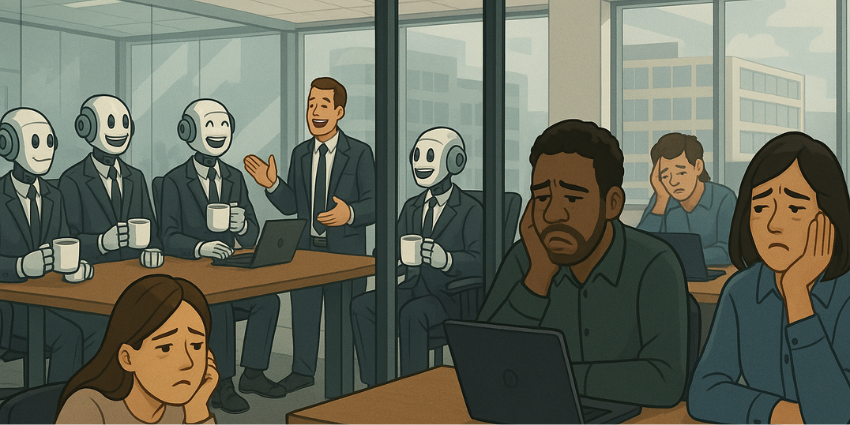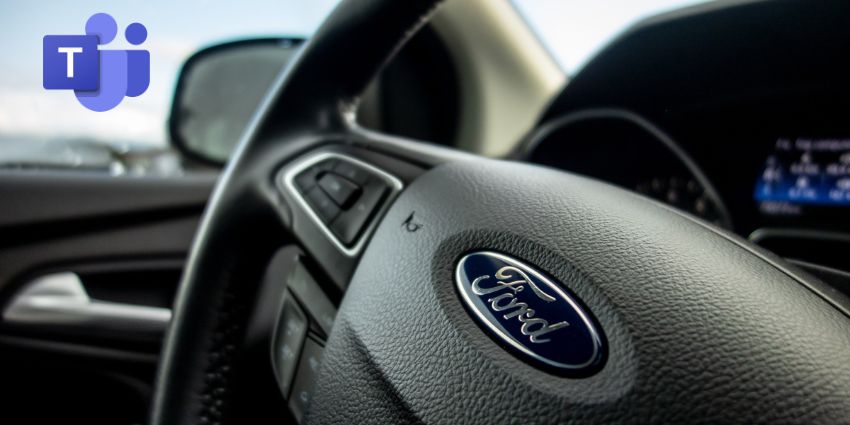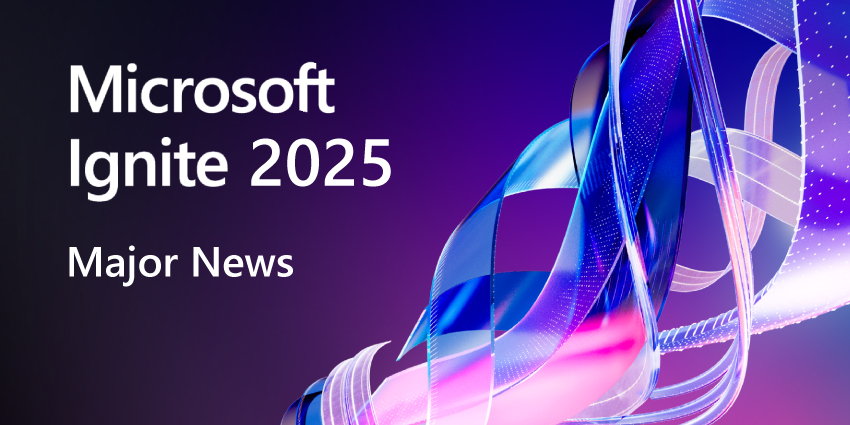Work is supposed to be better than ever, right? We’ve got hybrid and remote jobs making long commutes obsolete. Wellness programs are growing up, and employers actually care about inclusion and diversity. We’ve even got AI bots that can attend annoying meetings for us.
So why are burnout levels at about 66%? Why is it still so hard for companies to attract and actually keep the right talent? Because companies still focus more on tech than people.
75% of companies now run multiple AI agents, which feels ambitious, considering most employees are still trying to figure out where the AI’s responsibilities end and theirs begin.
We’ve decided AI/human hybrid teams are the future, but we haven’t even begun to figure out the balance. Work is accelerating past the humans doing it, and psychological safety at work is wobbling.
You can see the strain in the numbers. Quantum Workplace found that employees who use AI heavily experience 45% more burnout, which makes sense when you’re expected to collaborate with tools that never rest. S&P Global also reports AI-related initiative abandonment jumping from 17% to 42%, which says a lot about how overwhelming this all feels inside organizations.
This is why AI psychological safety has become the make-or-break factor in Agentic AI adoption. It’s not fear of job loss. It’s the fear of losing a say. If that isn’t addressed, even the smartest automation will struggle to earn trust.
What Agentic AI Really Means for the Workplace
The funny thing about agentic AI is that everyone talks about it like it’s still somewhere “on the horizon,” even though these systems are already making real decisions inside thousands of organizations. They re-route tasks, monitor signals, call APIs, and pull entire workflows together like a seasoned ops lead. It’s equally exciting and scary.
When they’re designed well, agents behave like hyper-capable coworkers who handle the multi-step jobs everyone else avoids. They escalate issues, reorganize work, and react to shifting conditions without waiting for instructions. It’s the closest thing modern workplaces have ever had to autonomous execution.
Look at the NHS Copilot rollout. One of the clearest examples is the NHS Copilot rollout. About 30,000 staff across 90 NHS organizations used the tool, saving roughly 43 minutes per day per person, around 400,000 hours a month at scale.
A global bank built an “agentic digital factory” to modernize nearly 400 legacy systems. The result? More than a 50% reduction in time and effort, and employees shifted from repetitive tasks into higher-judgement supervisory roles
Once you see the outcomes, the surge in adoption makes sense.
Numbers like that are impressive for business leaders, but open a whole new can of worms with employees. It’s not that people hate AI (most of us use it every day). It’s that we don’t understand what these new “coworkers” are really doing behind the scenes, and what’s left over for us.
So adoption falters, and all those plans you once had for the ultimate augmented workplace inevitably end up on the scrap heap.
How Agentic AI Threatens Psychological Safety at Work
With a little luck, if you’ve been investing in finding ways to actually improve the employee experience in the last few years, you know the basics of “psychological safety 101”.
Essentially, it comes down to this: the feeling that employees can speak up about concerns, bad ideas, broken workflows, even their own mistakes, without worrying that doing so will hurt them. That’s it.
Simple concept, but it’s always been fragile. It cracks around power dynamics, perfectionism, rushed deadlines, and leaders who talk about openness but don’t model it. Now layer on AI systems making decisions faster than most people can track, and you’ve got a brand-new set of fault lines.
Agentic AI doesn’t just change tasks; it changes the emotional contract between people and their workplace. If employees don’t understand what the AI is doing, or why it’s doing it, they stop speaking up. Once the voice dries up, everything else follows.
1. Silent Decision-Making
One of the sneakiest risks is how quietly AI agents work. They reroute priorities, trigger escalations, or handle a task end-to-end without announcing themselves half the time. Just look at tools like Zoom Tasks, do you really know why your companion is assigning you specific jobs, or do you just accept it? Eventually, questions like that spawn new ones.
People think: If work is happening without me… am I being phased out? Or worse: If the system makes a mistake, will it look like it was mine?
2. The “Surveillance Vibe”
Even when agents aren’t designed to monitor people, that’s how it often feels. When every click, field, or trend can become an input to an AI decision, workers start wondering how much is being tracked and how much is being interpreted.
A system doesn’t need to say, “I’m watching you” for people to assume it might be, particularly now that we know so many crucial workplace tools (like Microsoft Teams) are tracking more.
3. Loss of Voice & Autonomy
This might be the most emotionally loaded risk. It’s not job loss people fear most (although that’s a biggie); it’s losing influence.
In meetings, employees share that they’re hesitant to question AI recommendations because it makes them feel uninformed or technically behind. Others don’t want to raise concerns about mistakes, assuming leadership will “side with the system.” Some stay quiet simply because the AI’s outputs show up polished and confident, even when they’re wrong.
When humans assume their judgment matters less than the software, AI psychological safety at work collapses.
4. AI Fatigue & Role Ambiguity
The stats paint a pretty honest picture: 75% of employees feel forced to use AI at work, and 40% aren’t sure how it fits into their role
People can only fake confidence for so long. The nonstop pace of tool launches, “mandatory” AI training, and shifting responsibilities has created a low-grade exhaustion across entire teams.
That sense of I should know this by now eats away at morale. It also makes people far less likely to admit confusion, which is exactly what destroys psychological safety in the long run.
(Read more about solving digital fatigue here.)
Psychological Pressure & Mental Health Strain
When AI starts handling tasks faster than people can even understand them, there’s a strange pressure to “keep up with the machine.” It creates a type of workplace anxiety that leaders rarely see directly but feel indirectly through burnout, hesitation, and disengagement.
People aren’t machines. They’re not meant to run at that pace. Deep down, everyone knows it, but that doesn’t mean they don’t feel the pressure.
Why Addressing These Risks Matters
So, why do we need a fix? A few reasons.
- Silent Agents + Silent Employees = Invisible Risk: If agents make decisions quietly and employees stop questioning them, problems scale in the background. You don’t get small issues; you get systemic ones.
- Psychological Safety Builds Trust in AI: Teams with high psychological safety are more confident experimenting with AI, raising concerns, and learning out loud. Without that cultural base, adoption becomes compliance, not engagement.
- Innovation Depends on Voice, Not Automation: This is the part leaders regularly underestimate. AI might accelerate work, but innovation still comes from people taking risks, suggesting strange ideas, challenging polished outputs, and admitting when something doesn’t make sense.
- Ethics & Compliance Need Human Courage: Bias doesn’t catch itself. Neither do hallucinations, misrouted tasks, or misinterpreted data. Humans need to feel secure enough to spot issues and speak up.
How to Maintain Psychological Safety at Work in the AI Era
Most of the tension around AI is emotional. People know the tech is coming. Most even want it. What they don’t want is to feel sidelined, second-guessed, or replaced by a system that moves faster than they can question it. If there’s one lesson emerging from early Agentic AI adoption, it’s this: the technology doesn’t break culture, but it exposes every weak joint you’ve been ignoring.
Psychological Safety at Work: Leadership Foundations
A lot of leaders say they want feedback, but AI rollouts tend to reveal who actually means it. When people don’t understand why a new agent behaves the way it does, or why their workflow is changing, the safest move is silence. No one wants to tell their boss their expensive bot sucks. So leaders have to over-invite input, and then respond in a way that shows it matters.
Anonymous feedback channels, open Q&A sessions, Slack threads for AI questions, retrospectives that aren’t just ceremonial… these things make a difference. When employees see their feedback influencing the system (or even just informing the next iteration), trust increases fast.
Framing still matters too. If the narrative is “AI is coming to optimize everything,” employees hear “AI is coming to evaluate everything.” Suddenly, psychological safety at work evaporates.
Leaders have to set a very different tone, one where AI is framed as a tool that supports judgment, not replaces it. A partner that handles the grunt work so people can focus on the stuff agents can’t do.
Organizational Design & Governance
This is where the real strain tends to surface. Without structure, agentic systems behave unpredictably. When tools feel unpredictable, employees feel unsafe.
Start with clarity. No one should have to guess:
- What does the agent own?
- What does the human own?
- When does the agent escalate?
- Who is accountable for outcomes?
Even basic boundary-setting reduces anxiety. When teams know the rules, they can relax into their work instead of constantly scanning for unintended consequences.
Then, get real about transparency and observability in agent workflows. Use tools to help teams track what agents are doing, why, and what data influences their decisions. Create your own dedicated agentic governance framework with:
- Guardrails for autonomy
- Standards for explainability
- Auditability requirements
- Escalation protocols
- Risk classifications for use cases
Oh, and speaking of workflows, don’t start big. Nothing builds trust like visible wins that don’t feel threatening. Admin workflows. Reporting. Data consolidation. Routine cross-system checks. These let employees see value without feeling replaced. Think of them as the “friendly introduction” phase of Agentic AI adoption, before the systems start touching high-stakes operational work.
Change Management at AI Speed
Agentic systems shift work faster than traditional change management ever planned for. So the approach has to evolve.
Companies usually bolt change management onto the end of a transformation then wonder why adoption stalls. AI doesn’t give you that luxury. The change work has to be part of the build itself: communication, training, open forums, role mapping, workflow redesign. All of it woven into the project from day one.
First step: overcommunication. People need repetition. They need context. They need the “why,” not just the “what.” More importantly, they need reassurance that:
- The AI is not secretly evaluating them
- Their judgment still matters
- Mistakes won’t be punished
- Escalation isn’t a failure
Second step: control.
One of the biggest contributors to AI fatigue and the impending problems with psychological safety at work we’re facing is the endless stream of platforms, dashboards, copilots, notifications, training modules, and “must-use” add-ons. The fastest way to rebuild psychological calm is to remove digital clutter. Consolidate tools. Slow the rollout.
Capability Building: Managers, Teams & Superusers
Now we’re getting into “better collaboration” territory, starting with managers.
Managers are the emotional buffer between employees and an AI-powered workflow. They need to know how the agent works and how to talk about it. They also need a new skill: spotting early signs of AI psychological safety slipping, like hesitation, apology language, people second-guessing themselves because “the AI said…”
A manager who can normalize experimentation makes adoption easier, but go beyond leadership. Cross-functional teams reduce fear faster than any training scheme. When marketing, operations, IT, security, and frontline staff design together, AI becomes “our system,” not “their system.”
If your employees start hitting blocks, don’t enroll them in yet another online course. Experiment. Create peer-to-peer learning strategies with AI champions. People learn best from people like them. A confident peer who says, “Yeah, I struggled with this too, here’s what helped,” does more to build trust than a CEO announcement ever will.
Sustaining Psychological Safety at Work
Most companies are just going to keep embracing more AI. That means your approach to fixing psychological safety has to be ongoing too. Invest in:
- Formal Feedback Loops for AI Decisions: Give employees an obvious place to question outputs, flag weird behavior, or propose changes without having to ask a supervisor first.
- Voice + Trust Metrics: If you want to protect psychological safety at work, measure it.
Survey questions with scales like “I feel safe questioning AI decisions” will give you a handy insight. Read more on recognising your employees here. - Safe-to-Fail Experimentation: People need sandboxes. They need space to break things without consequences. Nothing reduces fear like the freedom to mess up.
AI Will Stall without Psychological Safety at Work
It’s easy to get swept up in impressive case studies about agentic AI and copilots in the workplace. We all know these tools deliver amazing results. But if you let them drive your human employees away, all you’ll be left with is an assembly line, not a team.
Agentic systems, just like hybrid work, won’t automatically make work better. They make it faster, more efficient, and more insightful. But the human experience, the sense of meaning, contribution, influence, that doesn’t scale unless people feel safe.
That’s why psychological safety at work is the only real guardrail that keeps AI rollouts from turning into expensive mistakes. When people feel safe challenging AI decisions, adoption accelerates. When they don’t, the tools might run, but the culture underneath them cracks.
The organizations that get this right are the ones designing AI with people, not around them. They’re rethinking workflows, clarifying boundaries, showing their work, and inviting employees into the process instead of forcing change onto them. They treat psychological safety as a design requirement, the same way they’d treat security or compliance.
That’s the only way agentic systems will ever live up to their promise.
Ready to utilise AI safely and boost employee engagement at scale?
Explore AI and Collaboration: The New Power Duo Transforming Employee Engagement – your 2026 UC guide to trust, purpose, and productivity.







